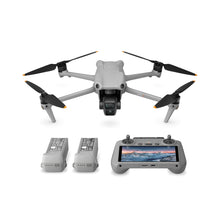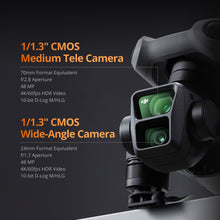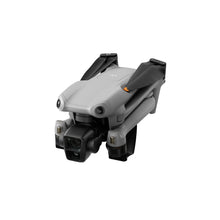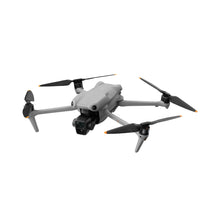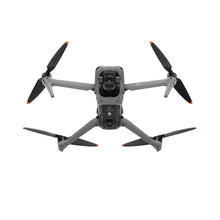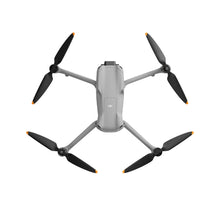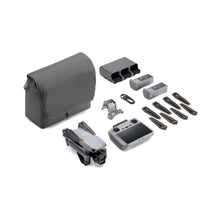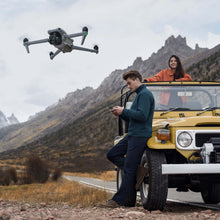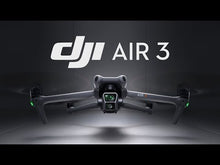DJI Air 3 Fly More Combo w/Smart controller (RC-2)

Click to find out more about our points program and save big!
Click to find out more about our low price promise
DJI Air 3 Fly More Combo (DJI RC-2)
Overview:
Includes DJI RC 2 with a 5.5-inch 1080p 700-nit high-bright screen, two additional batteries, a battery charging hub, and more.
Features:
1/1.3″ CMOS Medium Tele & Wide-Angle Dual Primary Cameras
46-Min Max Flight Time
Omnidirectional Obstacle Sensing
DJI O4 20km HD Video Transmission
Dual-Camera 48MP Photos
Dual-Camera 4K/60fps HDR Videos
DJI RC vs. RC 2: Key differences
At the outset, the RC 2 looks almost identical to the DJI RC. The sleek and lightweight device features a 5.5-inch, 1920×1080 built-in FHD screen capable of maintaining 700 nits of high brightness.
But on the inside, the device packs in considerable enhancements. For starters, RC 2 is equipped with a better processor that ensures improved CPU and GPU performance. As a result, you get an ultra-smooth app and system operation as well as a seamless aircraft control experience with every flight.
Another improvement comes in the form of additional antennas. DJI RC 2 integrates two built-in and two external antennas, thus supporting a dual-transmitter quad-receiver system. Essentially, you get double the number of both transmitter and receiver antennas compared to the previous generation RC, which means better signal strength and safer flights.
Further, the external antennas allow angle adjustments for optimized video transmission signals. The optimal transmission range occurs when the antennas are facing the aircraft, with the angle between the antennas and the back of the remote controller at 180 degrees or 270 degrees.
Another key distinguishing feature of the new drone remote controller is that the RC 2 supports DJI’s latest video transmission technology, O4.
With O4 compatibility, not only does the device offer a much higher transmission distance of up to 20 km, but it also improves transmission stability to avoid stuttered live views. You can expect up to 1080p/60fps live feeds from the RC 2, which coupled with a higher frame rate, translates into a much smoother viewing experience.








| Aircraft | |
| Takeoff Weight: | 720 g |
| Dimensions: | Folded (without propellers): 207×100.5×91.1 mm (L×W×H) Unfolded (without propellers): 258.8×326×105.8 mm (L×W×H) |
| Max Ascent Speed: | 10 m/s |
| Max Descent Speed: | 10 m/s |
| Max Horizontal Speed: | 21 m/s (at sea level, no wind) |
| Max Takeoff Altitude: | 6000 m |
| Max Flight Time: | 46 minutes Measured by DJI Air 3 flying at a constant speed of 28.8 kph in a windless environment at sea level, with APAS off, AirSense off, camera parameters set to 1080p/24fps, video mode off, and from 100% battery level until 0%. Data is for reference only. Always pay attention to reminders in the app during your flight. |
| Max Hovering Time: | 42 minutes Measured by DJI Air 3 hovering in a windless environment at sea level, with APAS off, AirSense off, camera parameters set to 1080p/24fps, video mode off, and from 100% battery level until 0%. Data is for reference only. Always pay attention to reminders in the app during your flight. |
| Max Flight Distance: | 32 km |
| Max Wind Speed Resistance: | 12 m/s |
| Max Pitch Angle: | 35° |
| Operating Temperature: | -10° to 40° C (14° to 104° F) |
| Global Navigation Satellite System: | GPS + Galileo + BeiDou |
| Hovering Accuracy Range: | Vertical: ±0.1 m (with vision positioning) ±0.5 m (with GNSS positioning) Horizontal: ±0.3 m (with vision positioning) ±0.5 m (with high-precision positioning system) Internal Storage: 8 GB |
| Camera | |
| Image Sensor: | Wide-Angle Camera: 1/1.3-inch CMOS, Effective Pixels: 48 MP Medium Tele Camera: 1/1.3-inch CMOS, Effective Pixels: 48 MP |
| Lens: | Wide-Angle Camera FOV: 82° Format Equivalent: 24 mm Aperture: f/1.7 Focus: 1 m to ∞ Medium Tele Camera FOV: 35° Format Equivalent: 70 mm Aperture: f/2.8 Focus: 3 m to ∞ |
| ISO Range: | Video Normal and Slow Motion: 100-6400 (Normal) 100-1600 (D-Log M) 100-1600 (HLG) Night: 100-12800 (Normal) Photo 100-6400 (12 MP) 100-3200 (48 MP) |
| Shutter Speed: | Wide-Angle Camera 12MP Photo: 1/16000-2 s (2.5-8 s for simulated long exposure) 48MP Photo: 1/8000-2 s Medium Tele Camera 12MP Photo: 1/16000-2 s (2.5-8 s for simulated long exposure) 48MP Photo: 1/8000-2 s |
| Max Image Size: | Wide-Angle Camera: 8064×6048 Medium Tele Camera: 8064×6048 |
| Still Photography Modes: | Wide-Angle Camera Single Shot: 12 MP and 48 MP Burst Shooting: 12 MP, 3/5/7 frames; 48 MP, 3 frames Automatic Exposure Bracketing (AEB): 12 MP, 3/5 frames; 48 MP, 3 frames at 0.7 EV step Timed: 12 MP, 2/3/5/7/10/15/20/30/60 s; 48 MP, 5/7/10/15/20/30/60 s Medium Tele Camera Single Shot: 12 MP and 48 MP Burst Shooting: 12 MP, 3/5/7 frames; 48 MP, 3 frames Automatic Exposure Bracketing (AEB): 12 MP, 3/5 frames; 48 MP, 3 frames at 0.7 EV step Timed: 12 MP, 2/3/5/7/10/15/20/30/60 s; 48 MP, 5/7/10/15/20/30/60 s |
| Photo Format: | JPEG/DNG (RAW) |
| Video Resolution: | Wide-Angle Camera: H.264/H.265 4K: 3840×2160@24/25/30/48/50/60/100*fps FHD: 1920×1080@24/25/30/48/50/60/100*/200*fps 2.7K Vertical Shooting: 1512×2688@24/25/30/48/50/60fps FHD Vertical Shooting: 1080×1920@24/25/30/48/50/60fps Medium Tele Camera: H.264/H.265 4K: 3840×2160@24/25/30/48/50/60/100*fps FHD: 1920×1080@24/25/30/48/50/60/100*/200*fps 2.7K Vertical Shooting: 1512×2688@24/25/30/48/50/60fps FHD Vertical Shooting: 1080×1920@24/25/30/48/50/60fps * Recording frame rates. The corresponding video plays as slow-motion video. 4K/100fps only supports H.265. |
| Video Format: | MP4 (MPEG-4 AVC/H.264, HEVC/H.265) |
| Max Video Bitrate: | H.264/H.265: 150 Mbps |
| Supported File System: | exFAT |
| Color Mode and Sampling Method: | Wide-Angle Camera Normal: 8-bit 4:2:0 (H.264/H.265) HLG/D-Log M: 10-bit 4:2:0 (H.265) Medium Tele Camera Normal: 8-bit 4:2:0 (H.264/H.265) HLG/D-Log M: 10-bit 4:2:0 (H.265) |
| Digital Zoom: | Wide-Angle Camera: 1-3x Medium Tele Camera: 3-9x |
| Gimbal | |
| Stabilization: | 3-axis mechanical gimbal (tilt, roll, pan) |
| Mechanical Range: | Tilt: -135° to 70° Roll: -50° to 50° Pan: -27° to 27° |
| Controllable Range: | Tilt: -90° to 60° Pan: -5° to 5° |
| Max Control Speed (tilt): | 100°/s |
| Angular Vibration Range: | ±0.0037° |
| Sensing | |
| Sensing Type: | Omnidirectional binocular vision system, supplemented with an infrared sensor at the bottom of the aircraft |
| Forward: | Measurement Range: 0.5-18 m Detection Range: 0.5-200 m Effective Sensing Speed: Flight Speed ≤ 12 m/s FOV: Horizontal 90°, Vertical 72° |
| Backward: | Measurement Range: 0.5-18 m Effective Sensing Speed: Flight Speed ≤ 12 m/s FOV: Horizontal 90°, Vertical 72° |
| Lateral: | Measurement Range: 0.5-30 m Effective Sensing Speed: Flight Speed ≤ 12 m/s FOV: Horizontal 90°, Vertical 72° |
| Upward: | Measurement Range: 0.5-18 m Effective Sensing Speed: Flight Speed ≤ 6 m/s FOV: Front and Back 72°, Left and Right 90° |
| Downward: | Measurement Range: 0.3-14 m Effective Sensing Speed: Flight Speed ≤ 6 m/s FOV: Front and Back 106°, Left and Right 90° |
| Operating Environment: | Forward, Backward, Left, Right, and Upward: Surfaces with discernible patterns and adequate lighting (lux > 15) Downward: Surfaces with discernible patterns, diffuse reflectivity > 20% (e.g. walls, trees, people), and adequate lighting (lux > 15) |
| 3D Infrared Sensor: | Measurement Range: 0.1-8 m (reflectivity > 10%) FOV: Front and Back 60°, Left and Right 60° |
| Video Transmission | |
| Video Transmission System: | O4 |
| Live View Quality: | Remote Controller: 1080p/30fps, 1080p/60fps |
| Operating Frequency: | 2.4000-2.4835 GHz 5.170-5.250 GHz 5.725-5.850 GHz 5.170-5.250 GHz can be used only in countries and regions where permitted by local laws and regulations. |
| Transmitter Power (EIRP): | 2.4 GHz: < 33 dBm (FCC) < 20 dBm (CE/SRRC/MIC) 5.1 GHz: < 23 dBm (CE) 5.8 GHz: < 33 dBm (FCC) < 30 dBm (SRRC) < 14 dBm (CE) |
| Max Transmission Distance: (unobstructed, free of interference) | FCC: 20 km CE: 10 km SRRC: 10 km MIC: 10 km Measured in an unobstructed outdoor environment free of interference. The above data shows the farthest communication range for one-way, non-return flights under each standard. Always pay attention to RTH reminders in the app during your flight. |
| Max Transmission Distance: (unobstructed, with interference) | Strong Interference: urban landscape, approx. 1.5-4 km Medium Interference: suburban landscape, approx. 4-10 km Low Interference: suburb/seaside, approx. 10-20 km Data tested under FCC standard in unobstructed environments with typical interference. Used for reference purposes only and provides no guarantee for actual transmission distance. |
| Max Transmission Distance: (obstructed, with interference) | Low Interference and Obstructed by Buildings: approx. 0-0.5 km Low Interference and Obstructed by Trees: approx. 0.5-3 km Data tested under FCC standard in obstructed environments with typical low interference. Used for reference purposes only and provides no guarantee for actual transmission distance. |
| Max Download Speed: | O4: 10 MB/s (with DJI RC-N2 Remote Controller) 10 MB/s (with DJI RC 2) Wi-Fi 5: 30 MB/s* * Measured in a laboratory environment with little interference in countries/regions that support both 2.4 GHz and 5.8 GHz. Download speeds may vary depending on the actual conditions. |
| Lowest Latency: | Aircraft + Remote Controller: approx. 120 ms Depending on the actual environment and mobile device. |
| Antenna: | 6 antennas, 2T4R |
| Wi-Fi | |
| Protocol: | 802.11 a/b/g/n/ac |
| Operating Frequency: | 2.400-2.4835 GHz 5.725-5.850 GHz |
| Transmitter Power (EIRP): | 2.4 GHz: < 20 dBm (FCC/CE/SRRC/MIC) 5.8 GHz: < 20 dBm (FCC/SRRC) < 14 dBm (CE) |
| Bluetooth | |
| Protocol: | Bluetooth 5.2 |
| Operating Frequency: | 2.400-2.4835 GHz |
| Transmitter Power (EIRP): | < 10 dBm |
| Battery | |
| Capacity: | 4241 mAh |
| Weight: | Approx. 267 g |
| Nominal Voltage: | 14.76 V |
| Max Charging Voltage: | 17 V |
| Type: | Li-ion 4S |
| Energy: | 62.6 Wh |
| Charging Temperature: | 5° to 40° C (41° to 104° F) |
| Charging Time: | Approx. 80 minutes (with DJI 65W Portable Charger) Approx. 60 minutes (with DJI 100W USB-C Power Adapter and Battery Charging Hub) |
| Charger | |
| Input: | DJI 65W Portable Charger: 100-240 V (AC), 50-60 Hz, 2 A DJI 100W USB-C Power Adapter: 100-240 V (AC), 50-60 Hz, 2.5 A |
| Output: | DJI 65W Portable Charger: USB-C 5 V, 5 A 9 V, 5 A 12 V, 5 A 15 V, 4.3 A 20 V, 3.25 A 5-20 V, 3.25 A USB-A 5 V, 2 A DJI 100W USB-C Power Adapter: Max 100 W (total) When both ports are used, the max output power of one port is 82 W, and the charger will dynamically allocate the output power of the two ports according to the power load. |
| Rated Power: | DJI 65W Portable Charger: 65 W DJI 100W USB-C Power Adapter: 100 W |
| Battery Charging Hub | |
| Input: | USB-C: 5-20 V, max 5 A |
| Output (power accumulation): | Battery Port: 12-17 V, 3.5 A |
| Output (charging): | Battery Port: 12-17 V, max 5 A |
| Output (USB): | USB-C: 5 V, 3 A 9 V, 5 A 12 V, 5 A 15 V, 5 A 20 V, 4.1 A |
| Charging Type: | Three batteries charged in sequence. |
| Compatibility: | DJI Air 3 Intelligent Flight Battery |
| Car Charger | |
| Input: | Car Power Input: 12.7-16 V, 6.5 A, rated voltage 14 V (DC) |
| Output: | USB-C: 5 V, 5 A 9 V, 5 A 12 V, 5 A 15 V, 4.3 A 20 V, 3.25 A 5-20 V, 3.25 A USB-A: 5 V, 2 A |
| Rated Power: | 65 W |
| Charging Temperature: | 5° to 40° C (41° to 104° F) |
| Storage | |
| Recommended microSD Cards: | SanDisk Extreme PRO 32GB V30 U3 A1 microSDHC Lexar 1066x 64GB V30 U3 A2 microSDXC Lexar 1066x 128GB V30 U3 A2 microSDXC Lexar 1066x 256GB V30 U3 A2 microSDXC Lexar 1066x 512GB V30 U3 A2 microSDXC Kingston Canvas GO! Plus 64GB V30 U3 A2 microSDXC Kingston Canvas GO! Plus 128GB V30 U3 A2 microSDXC Kingston Canvas React Plus 64GB V90 U3 A1 microSDXC Kingston Canvas React Plus 128GB V90 U3 A1 microSDXC Kingston Canvas React Plus 256GB V90 U3 A1 microSDXC Samsung EVO Plus 512GB V30 U3 A2 microSDXC |
| DJI RC-N2 Remote Controller | |
| Model: | RC151 |
| Max Operating Time: | Without charging any mobile device: 6 hours When charging a mobile device: 3.5 hours |
| Max Supported Mobile Device Size: | 180×86×10 mm (L×W×H) |
| Operating Temperature: | -10° to 40° C (14° to 104° F) |
| Charging Temperature: | 5° to 40° C (41° to 104° F) |
| Charging Time: | 2.5 hours |
| Charging Type: | It is recommended to use a 5V/2A charger. |
| Battery Capacity: | 18.72 Wh (3.6 V, 2600 mAh × 2) |
| Type: | 18650 Li-ion |
| Dimensions: | 104.22×149.95×45.25 mm (L×W×H) |
| Weight: | 375 g |
| Supported Mobile Device Port Type: | Lightning, USB-C, Micro-USB Using a mobile device with Micro-USB port requires the DJI RC-N1 RC Cable (Standard Micro USB connector), which is sold separately. |
| Video Transmission Operating Frequency: | 2.4000-2.4835 GHz 5.170-5.250 GHz 5.725-5.850 GHz |
| Video Transmission Transmitter Power (EIRP): | 2.4 GHz: < 33 dBm (FCC) < 20 dBm (CE/SRRC/MIC) 5.1 GHz: < 23 dBm (CE) 5.8 GHz: < 33 dBm (FCC) < 14 dBm (CE) < 30 dBm (SRRC) |
DJI Air 3 - Quick Start Guide (DJI RC 2) v1.0.
DJI Air 3 - Quick Start Guide (DJI RC-N2) v1.0.
DJI Air 3 - Safety Guidelines (DJI RC 2) v1.0.
DJI Air 3 - Safety Guidelines (DJI RC-N2) v1.0.
DJI Air 3 - Safety Guidelines (DJI RC 2) (24 Languages) v1.0.
DJI Air 3 - Safety Guidelines (DJI RC-N2) (24 Languages) v1.0.
Compared with DJI Air 2S, what are the main upgrades of DJI Air 3?
DJI Air 3 has improved the camera system, video transmission system, vision sensing system, flight time, and intelligent features. Details are as follows:
- A 1/1.3-inch CMOS 70mm medium tele camera has been added to complement the 1/1.3-inch CMOS 24mm wide-angle camera, delivering consistent image quality* and more dynamic imaging possibilities.
- The video transmission system has been upgraded to the next-gen O4 HD video transmission system, which not only delivers an FHD video transmission from a max range of 20 km, but also features enhanced anti-interference capabilities, further improving the transmission stability. The remote controller also supports a 1080p/60fps max real-time live feed, with the higher frame rate delivering a smoother viewing experience.
- Equipped with an omnidirectional vision sensing system, the drone can detect obstacles in all directions. When obstacles are detected, the drone can use APAS 5.0 to perform smoother avoidance movements for a safer overall flight experience.
- The max hovering time and the max flight time are 42 minutes and 46 minutes respectively, which are 40% and 48% higher than those of DJI Air 2S respectively, allowing you to create with peace of mind.
- The drone supports Waypoint Flight, Advanced RTH, Cruise Control, QuickTransfer, and other intelligent functions, greatly improving creative efficiency.
* The wide-angle camera and medium tele camera have different apertures.
Compared with the O3 video transmission system, what are the upgrades of the O4 video transmission system?
The O4 video transmission system adopts an all-new hardware solution. The aircraft antenna system is upgraded from four antennas to six, and a new frequency band* has been added. The communication algorithm has also been upgraded, which not only delivers an FHD video transmission from a max range of 20 km**, but also features enhanced anti-interference capabilities, further improving the transmission stability in complex environments like urban settings. The remote controller also supports a 1080p/60fps max real-time live feed, with the higher frame rate delivering a smoother viewing experience.
* Can be used only in countries and regions where it is allowed by local laws and regulations.
** Measured in an open outdoor environment without interference and with FCC compliance. The above data shows the farthest communication range for one-way, non-return flights. Always pay attention to reminders in the app during your flight.
Compared with DJI RC-N2, what are the advantages of DJI RC 2? How should I choose?
When using DJI RC-N2, you need to connect your smartphone and download the DJI Fly app. DJI RC 2 comes with a 5.5-inch 1080p FHD screen with a brightness of up to 700 nits, delivering a better outdoor viewing experience. Additionally, with the DJI Fly app pre-installed, you can enjoy immediate use after powering on without connecting to your smartphone, facilitating concentrated and efficient creation.
Compared with the DJI RC-N1 Remote Controller, what are the upgrades of the DJI RC-N2 Remote Controller?
The video transmission solution has been upgraded, and the antenna system is upgraded from 1T2R to 2T2R. With DJI Air 3, the O4 video transmission can be used.
Compared with DJI RC, what are the upgrades of DJI RC 2?
The performance of the processor is improved for smoother operation. The video transmission solution has been upgraded, and the antenna system has been upgraded from 1T2R to 2T4R. With DJI Air 3, O4 video transmission can be used. DJI RC 2 features two built-in antennas and two external antennas, and also allows angle adjustments for the external dual antennas to achieve better video transmission effects.
How is ActiveTrack 5.0 different from ActiveTrack 4.0?
ActiveTrack 5.0 can track subjects in eight directions, enabling more creative possibilities. Embedded with advanced subject recognition technology, ActiveTrack 5.0 uses multiple vision sensors simultaneously to recognize a subject, differentiate it from other objects, and lock the subject in the frame. It allows you to adjust tracking angles smoothly for more natural results. Thanks to the new environment and subject-sensing algorithms, DJI Air 3 responds earlier to subject movements and environmental information and plans an optimal tracking route to record smooth and stable footage.
Does DJI Air 3 support vertical shooting?
Both the wide-angle camera and medium tele camera support vertical shooting (9:16), and the max shooting specification is 2.7K/60fps.
Does DJI Air 3 support shooting D-Log M and HLG videos?
Both the wide-angle camera and medium tele camera support shooting 10-bit D-Log M and 10-bit HLG videos. 10-bit D-Log M mode facilitates more flexible color grading in post-production, and 10-bit HLG mode can achieve previews with higher dynamic range (requires equipment that supports HDR display).
The following products could help or might be needed with this product.








